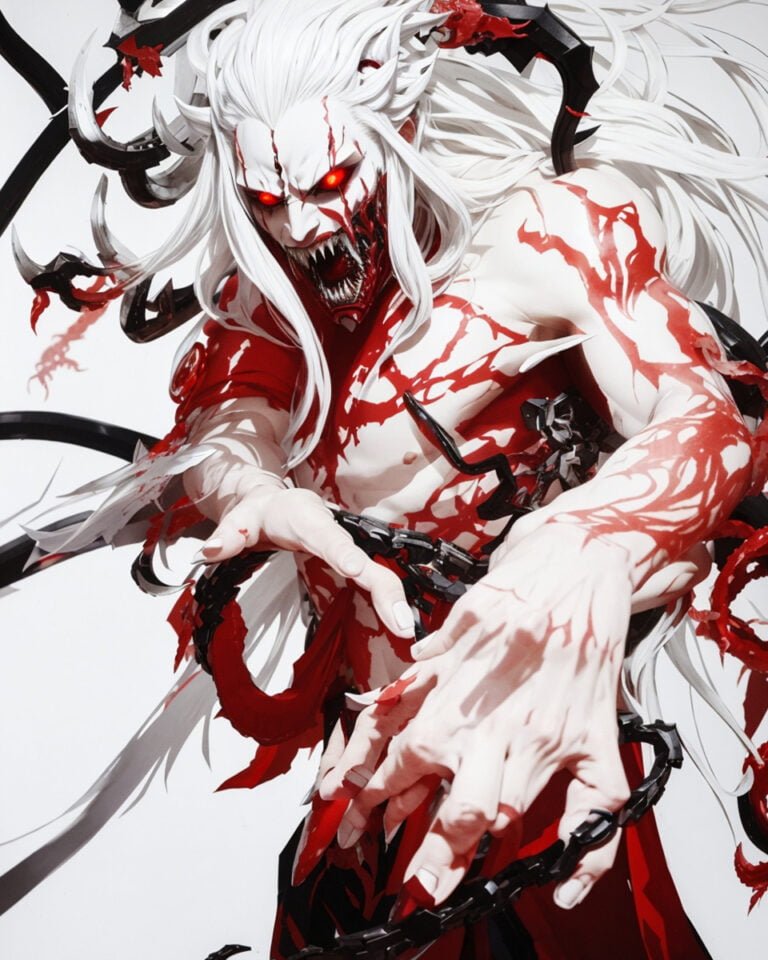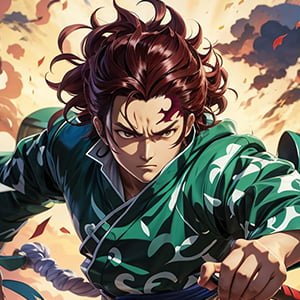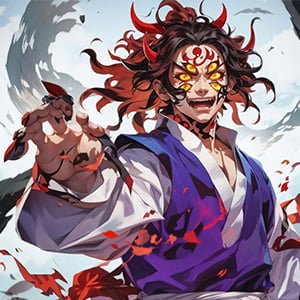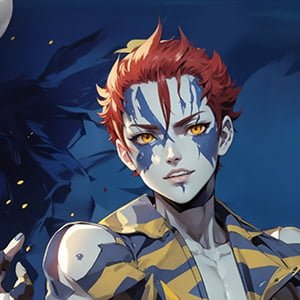Who is Muzan Kibutsuji?
Muzan Kibutsuji serves as the central antagonist in the ‘Demon Slayer’ series, holding the significant title of the first demon and the origin of all subsequent demons. His character is marked by a chilling ruthlessness and an unwavering pursuit of eternal life. Possessing unique shape-shifting abilities, Muzan can seamlessly integrate into human society, posing a constant challenge for the Demon Slayer Corps.
Centuries ago, during the Heian Era, Muzan’s transformation into a demon occurred as a result of an experimental procedure aimed at curing a fatal disease. Since then, his primary objectives have revolved around achieving true immortality, either through the elusive Blue Spider Lily or by creating more demons, hoping one might overcome the vulnerability to sunlight. Despite the ever-changing nature of his appearance, Muzan is often depicted as a refined gentleman with unmatched strength and capabilities.
Muzan Kibutsuji also plays a crucial as the main antagonist in the Hashira Training Arc, and plays a critical role in setting up the final battle against him and his allies, learn more below:
What Defines Demon Slayer’s Main Villain, Muzan Kibutsuji’s Personality?
Despite his monstrous nature, Muzan Kibutsuji exhibits a complex personality rooted in a deep-seated fear of death, stemming from a near-death experience in his human life. This fear fuels his relentless pursuit of immortality and drives his desire to eradicate the Demon Slayer Corps, perceived as a threat to his existence. Beyond his malevolent exterior, the primary antagonist reveals a twisted sense of family, referring to the demons he creates as his “children” and demanding absolute loyalty from them. Maintaining a hidden human side, he conceals his true nature from his wife and daughter, adding layers to his character and transcending the typical villain archetype.
Muzan’s manipulative and ruthless nature is evident in his control over other demons, promising power or a place by his side in exchange for loyalty. Relentlessly eliminating those who fail him, especially the Lower Moons, underscores his determination to destroy the Demon Slayer Corps. His quest for perfection, driven by a fear of death, leads to experiments on other demons.
As the king of demons, Muzan embodies callousness, ruthlessness, intimidation, tyranny, heartlessness, egomania, and extreme narcissism. Despite his seemingly invincible strength, he remains haunted by his vulnerability to sunlight, which compels him to turn humans into demons in the hope of finding one immune to sunlight. His manipulation of minions and desire for self-preservation reveal a complex character driven by a relentless pursuit of perfection and immortality. Muzan’s behavior is marked by a deep-seated hatred for failure, leading to brutal purges of the Lower Ranks and a relentless pursuit of his goals. He sees his subordinates as disposable tools, using them for his own ends and showing no remorse in their elimination. His cowardice becomes evident in his avoidance of direct conflict, preferring to manipulate others to do his bidding while preserving his own safety.
His inflated ego, delusional self-worth, and obsession with perfection make him intolerant of mockery or correction. Muzan’s extreme narcissism leads him to view himself as a near-perfect being, intolerant of any deviation from his vision. He berates and eliminates those who fail him, showcasing a brutal streak that reinforces his god complex. Despite his intelligence and manipulation skills, Demon Slayer’s main villain is fundamentally driven by a fear of death and a desire for self-preservation. His cunning allows him to seamlessly blend into human society, showcasing a fondness for high fashion and academic learning. However, his vulnerability is laid bare in his final moments as he confronts the inevitability of death, reflecting on his life choices and seeking a form of immortality through leaving a legacy.
During a confrontation with Kagaya Ubuyashiki, Muzan was met with a tone of pity and sadness from the man. Despite the potential for understanding or empathy, Muzan interpreted these sentiments as insults and threats, further emphasizing his intense hatred for humanity and the Demon Slayers. This interaction highlights the contrast between Muzan’s ruthless exterior and the underlying vulnerabilities that contribute to his complex character in Demon Slayer.
Muzan’s loathing of change, equating it to decay and imperfection, reflects his obsessive perfectionism. He despises any form of alteration, be it physical, emotional, or circumstantial. His disdain for humanity as a sign of weakness is evident in his critique of Gyutaro, whom he believes lost due to his attachment to his sister Daki. Muzan derides the Upper Ranks, ranking them based on how much humanity they retain, showcasing his aversion to change and decay.
Behind the façades he presents, Muzan is remarkably cowardly, always seeking to avoid conflict whenever possible. His encounter with Giyu Tomioka and Tanjiro Kamado underscores his reluctance to confront unpleasant situations, urging them to accept survival as sufficient and discouraging the cycle of revenge. This cowardice contrasts starkly with his god complex and reinforces the complexity of Muzan Kibutsuji’s character in Demon Slayer.
Muzan’s Origin and Appearance
Muzan Kibutsuji is characterized by his tall, lean, and muscular figure, adorned in a distinctive ensemble. His appearance features pale skin, curly black hair, almond-shaped eyes, and long blue nails. He is often seen wearing a white fedora with a bow, complemented by a matching suit. Some fans have drawn comparisons between Muzan’s look and that of the late Michael Jackson.
In terms of age, Muzan’s physical appearance resembles that of a young man in his late twenties, with bright orange eyes and distinct features. Despite his youthful exterior, the main antagonist has been alive for over a thousand years, concealing his true age and the depth of his experiences.
The revelation of Muzan’s origin unfolds in the season finale of the “Demon Slayer Swordsmith Village Arc.” During the Heian era (794–1185), Muzan was a young noble facing a mysterious terminal illness that threatened to claim his life before his 19th birthday. Seeking a cure, he underwent an experimental treatment that inadvertently transformed him into a demon. This event marked the beginning of Muzan’s enduring existence as the progenitor of all demons.
Despite his prolonged life span, much about the main villain of Demon Slayer’s history remains shrouded in mystery. His demonic nature and the experimental treatment raise questions about potential undiscovered powers and abilities that may yet be revealed.
What are Muzan Kibutsuji Powers and Fighting Style?
Overall Abilities:
Incomparable Strength:
Muzan is considered the strongest demon, easily overpowering multiple Demon Slayers, including high-ranking Hashira.
Immeasurable Speed:
Muzan’s movements are so fast that even skilled Demon Slayers struggle to perceive and react to his attacks.
Whip Proficiency:
Muzan utilizes bladed and flexible whips as his primary form of attack, contorting his arms, back, and thighs to unleash devastating attacks.
Nigh-Absolute Regeneration:
Muzan can regenerate from injuries at an unprecedented speed, overcoming even the weaknesses of decapitation.
Genius Intellect:
Muzan has lived for over a millennium, making him extremely clever and erudite. He can manipulate demons to serve his purposes, showing expertise in various fields like chemistry, biology, and foreign languages. Skilled at reading negative emotions, he manipulated his wives into committing suicide.
Demon Abilities:
Biological Absorption:
Muzan can absorb and assimilate organic and inorganic objects, enhancing his own powers.
Combat Form:
Muzan can transform into a monstrous battle form, with a dark-red scale-like mass covering his body, sharp-toothed mouths, and longer pale white hair.
Arm Whips:
Muzan can elongate his arms into bladed whips, rotating them at immense speeds for precise and deadly attacks.
Back Whips:
Additional whips extend from his back, increasing the number of simultaneous attacks he can unleash.
Thigh Whips:
Whips attached to his thighs allow him to attack from blind spots, overpowering even highly skilled Demon Slayers.
Nigh-Absolute Regeneration:
Muzan possesses the fastest and most advanced regeneration among demons, overcoming decapitation and severe injuries.
Transformative Blood:
Muzan’s blood transforms humans into demons, granting enhanced abilities and regeneration.
Blood Memory Transfer:
Muzan can transfer his blood and memories to a suitable host, reviving them as a demon with his powers.
Consciousness Implantation:
Muzan can implant his consciousness into demons created with his blood, influencing their actions but giving them a chance to resist.
Demon Manipulation:
He can control demons to a certain extent, as seen when he took control of Nakime’s body temporarily.
Supernatural Abilities:
Extrasensory Perception:
Muzan possesses acute senses, easily detecting the presence of humans and wounded Demon Slayers from a distance.
Blood Demon Art – Biokinesis:
Shapeshifting:
Muzan can change his appearance, flesh, and organs at incredible speed, using this ability for disguise and combat.
Puppet Creation:
Muzan can create puppets of flesh and command them.
Unique Anatomy:
Muzan altered his own bodily properties, possessing seven hearts and five brains for enhanced constitution and resistance to decapitation.
What Makes Muzan Kibutsuji’s Transformation So Popular Among Fans?
After undergoing an experimental treatment that granted him a new body and altered physiology, Muzan’s blood acquires potent mutagenic properties capable of transforming humans into demonic creatures. This transformative aspect of his blood extends beyond mere metamorphosis, granting those who assimilate it a diverse range of special abilities. Notable among these abilities are powerful and swift regeneration, the capacity to manipulate their flesh, immortality, accelerated growth, heightened physical prowess, and the manifestation of supernatural skills known as Blood Demon Arts.
Deceptive Disguises: Muzan’s Mastery of Transformation
During a pivotal meeting with the Lower Ranks, Muzan showcased not only his blood’s transformative nature but also his adeptness at assuming different identities. Initially appearing as an elegant woman adorned in a long black yukata, his clever disguise confounded the Lower Ranks, preventing immediate recognition. Later in the same encounter, he executed another remarkable transformation, adopting the persona of the adopted sickly son to an elderly couple. In this guise, Muzan took on the appearance of a young child with pale, white skin, complemented by black, silky-smooth, neatly combed hair. His outfit, consisting of a plain white button-up shirt, black cargo shorts, long tube socks, and loafers, completed the deceptive disguise. The artful use of transformation becomes a strategic tool for Muzan in navigating the complexities of his interactions with the demon-slaying world.
What is Muzan’s, the Main Antogonist’s Biggest Weakness?
Muzan’s biggest weakness is exposure to sunlight. Demons in the series are vulnerable to sunlight, and Muzan, being the progenitor of demons, shares this weakness. Sunlight can severely harm and ultimately destroy him.
It has also been revealed that Muzan’s intense fear of death and his overwhelming desire to survive trace back to a unique and tragic origin. Muzan was born “dead,” and throughout his time in his mother’s womb, his heart would intermittently stop. Initially assumed to be stillborn, Muzan defied expectations by miraculously fighting for breath just before his cremation. This near-death experience had a profound impact on Muzan, instilling in him a deep-seated terror of mortality and propelling his unwavering pursuit of immortality.
Was Muzan inspired by Micheal Jackson?
While there is no official confirmation that Muzan Kibutsuji from Demon Slayer was directly inspired by Michael Jackson, the fanbase has extensively discussed the uncanny resemblances between the two. Numerous Michael Jackson memes circulated within the community, with fans noting the similarities in Muzan’s design to the late King of Pop. This resemblance was particularly striking in Muzan’s hair design, complexion, and choice of clothing, leading many to draw parallels between the two iconic figures.
When Muzan was initially revealed, the fanbase widely speculated that he might have been modeled after Michael Jackson. The resemblance was evident in Muzan’s first outfit in the anime, where he sported a white fedora and a three-piece suit reminiscent of an outfit Michael Jackson had worn in the past. The only notable difference was the color of the suit, as Muzan’s was black while Michael Jackson’s was white. Additionally, Muzan’s curly hair bore a resemblance to Michael Jackson’s distinctive hairstyle.
While these similarities sparked discussions and memes within the fanbase, it’s important to note that there is no official confirmation or statement from the creators of Demon Slayer regarding any direct inspiration from Michael Jackson for the character of Muzan Kibutsuji.
How Muzan became a demon in Demon Slayer?
Muzan Kibutsuji’s transformation into a demon in Demon Slayer traces back to his initial existence as a sick individual seeking a cure for a mysterious ailment. As a patient, he grew increasingly impatient with the lack of positive results from a doctor attempting to treat him. Fueled by his impatience, Muzan took drastic measures, ultimately resorting to killing the doctor before receiving the prescribed Blue Spider Lily medicine.
Following the doctor’s demise, Muzan experienced not only a recovery from his illness but also a noticeable enhancement in strength and endurance. However, this newfound vitality came at a cost—he developed a craving for human flesh and required their blood to sustain his existence. Additionally, Muzan found himself vulnerable to sunlight, which inflicted severe burns and prevented him from walking during the daytime.
Know more about the primary antagonist, Muzan
Why did Muzan turn evil?
Muzan Kibutsuji’s turn to evil in Demon Slayer is not solely driven by his desire to survive in sunlight. What defines his malevolence is his complete disregard for anything beyond his own interests. His selfishness is evident in his sole focus on personal benefit. For Muzan, every demon exists merely as a tool to serve his needs and desires. The core of his evil nature lies in this profound self-centeredness, where the well-being and purpose of others are entirely secondary to his own agenda.
Who is the main villain in Demon Slayer?
The main villain in Demon Slayer is Muzan Kibutsuji. He serves as the main antagonist throughout the series, driving the narrative with his malevolent actions and relentless pursuit of immortality. Muzan is the powerful and cunning leader of demons, posing a significant threat to the Demon Slayer Corps and humanity.
Why does Muzan Kibutsuji look like Mj?
Muzan Kibutsuji looks like MJ primarily because of the resemblance in outfit, such as the white fedora and three-piece suit. The similarities in clothing, along with other features, have led fans to draw comparisons to the late King of Pop, Michael Jackson. It’s important to note that any likeness is likely coincidental, as there is no official confirmation of direct inspiration from Michael Jackson for Muzan’s character design.







